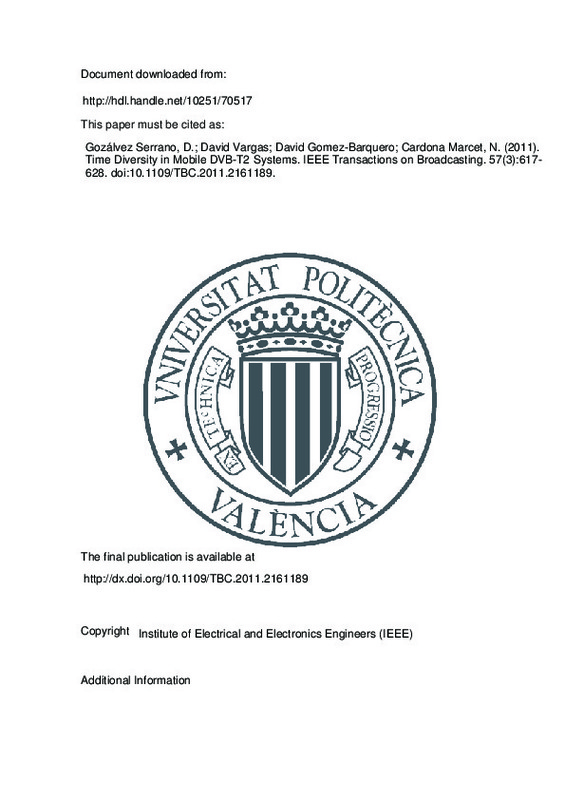Gozálvez Serrano, D.; Gómez Barquero, D.; Vargas, D.; Cardona Marcet, N. (2011). Time Diversity in Mobile DVB-T2 Systems. IEEE Transactions on Broadcasting. 57(3):617-628. doi:10.1109/TBC.2011.2161189
Por favor, use este identificador para citar o enlazar este ítem: http://hdl.handle.net/10251/70517
|
Título:
|
Time Diversity in Mobile DVB-T2 Systems
|
|
Autor:
|
Gozálvez Serrano, David

 Gómez Barquero, David
Vargas, D.
Gómez Barquero, David
Vargas, D.

 Cardona Marcet, Narciso
Cardona Marcet, Narciso
|
|
Entidad UPV:
|
Universitat Politècnica de València. Instituto Universitario de Telecomunicación y Aplicaciones Multimedia - Institut Universitari de Telecomunicacions i Aplicacions Multimèdia
Universitat Politècnica de València. Escuela Técnica Superior de Ingenieros de Telecomunicación - Escola Tècnica Superior d'Enginyers de Telecomunicació
|
|
Fecha difusión:
|
|
|
Resumen:
|
DVB-T2 implements a very flexible time interleaving that allows multiple tradeoffs in terms of time diversity, latency and power saving. In this paper, we study in detail these tradeoffs in the context of mobile reception. ...[+]
DVB-T2 implements a very flexible time interleaving that allows multiple tradeoffs in terms of time diversity, latency and power saving. In this paper, we study in detail these tradeoffs in the context of mobile reception. Together with time diversity, we also investigate the impact of reduced time de-interleaving memory and Alamouti-based MISO in the mobile reception of DVB-T2 services. In addition, we propose the utilization of upper layer FEC protection in order to overcome the limitations of the DVB-T2 physical layer for the provision of long time interleaving, and enable fast zapping. The performance is evaluated by means of simulations in mobile channels that include the presence of fast fading and shadowing in the received signal. © 2010 IEEE.
[-]
|
|
Palabras clave:
|
Channel coding
,
DVB-T2
,
Mobile TV
,
Time diversity
,
Time interleaving
,
Deinterleaving
,
Fast fading
,
FEC protection
,
Mobile channels
,
Mobile reception
,
Physical layers
,
Power savings
,
Received signals
,
Time-interleaving
,
Upper layer
,
Fading channels
,
Television receivers
|
|
Derechos de uso:
|
Reserva de todos los derechos
|
|
Fuente:
|
IEEE Transactions on Broadcasting. (issn:
0018-9316
)
|
|
DOI:
|
10.1109/TBC.2011.2161189
|
|
Editorial:
|
Institute of Electrical and Electronics Engineers (IEEE)
|
|
Versión del editor:
|
http://dx.doi.org/10.1109/TBC.2011.2161189
|
|
Código del Proyecto:
|
info:eu-repo/grantAgreement/MICINN//AP2008-03293/ES/AP2008-03293/
info:eu-repo/grantAgreement/MITURCO//TSI-020400-2010-0108/ES/ENGINES/
|
|
Agradecimientos:
|
Manuscript received October 13, 2010; revised April 22, 2011; accepted May 11, 2011. Date of publication July 25, 2011; date of current version August 24, 2011. This work was supported in part by the Spanish Ministry of ...[+]
Manuscript received October 13, 2010; revised April 22, 2011; accepted May 11, 2011. Date of publication July 25, 2011; date of current version August 24, 2011. This work was supported in part by the Spanish Ministry of Industry, Tourism, and Commerce under the Celtic project Enabling Next-Generation Networks for Broadcast Services ENGINES (TSI-020400-2010-108). The work of D. Gozalvez was supported by the FPU Grant AP2008-03293 of the Spanish Ministry of Education.
[-]
|
|
Tipo:
|
Artículo
|







![[Cerrado]](/themes/UPV/images/candado.png)


